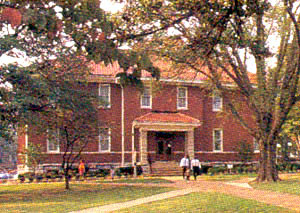
McKissack and McKissack Architects
The McKissack and McKissack architectural tradition dates back to the first Moses McKissack (1790-1865) of the West African Ashanti tribe, who was sold into slavery to William McKissack of North Carolina and became a master builder. In 1822 he married Mirian (1804-1865), a Cherokee, and they had fourteen children. The ninth child, Gabriel Moses McKissack (1840-1922), continued in the building trade he learned from his father. Like his father, Gabriel Moses II taught the building skills to his son, Moses McKissack III (1879-1952).
Moses McKissack III was born in Pulaski and received his formal education in the segregated Pulaski public schools. He initially worked with his father, but in 1890 a Pulaski architect employed him to draw, design, and assist in his construction business. Moses III’s adroitness in the trade earned him a reputation as an excellent craftsman. From 1895 to 1905 he built houses in Decatur, Alabama, as well as in Mount Pleasant and Columbia, Tennessee.
In 1905 Moses III moved to Nashville and opened his own construction business. That same year, he built a residence for the dean of architecture and engineering at Vanderbilt University. This led to commissions to design and build other residences in Nashville’s West End area. McKissack’s first major commission was in 1908 for the construction of the Carnegie Library at Fisk University. In 1909 he advertised as an architect in the Nashville City Directory. By 1920 McKissack was designing buildings for clients throughout Nashville and the state.
McKissack’s brother, Calvin Lunsford McKissack (1890-1968), assisted on most projects. In 1921, when the state professional registration law became effective, the McKissacks were among Tennessee’s first registered architects. A year later Calvin joined his brother as a business partner, and McKissack and McKissack became Tennessee’s first professional African American architectural firm. The firm’s architectural projects were located across the South, with most being African American educational and religious facilities and churches.
McKissack and McKissack received several federal Works Progress Administration contracts in the late 1930s. In 1942 they were awarded a $5.7 million contract for construction of the Ninety-ninth Pursuit Squadron Air Base (an African American combat air unit) in Tuskegee, Alabama. This World War II contract was the largest ever granted by the federal government to an African American company. The McKissacks also designed several federal housing projects. During President Franklin Roosevelt’s administration, Moses McKissack III received an appointment to the White House Conference on Housing Problems.
Following the death of his brother, Calvin McKissack became president and general manager of the firm until his own death in 1968. Leadership of the company then passed to Moses III’s son, William DeBerry McKissack (1925-1988), who served until a debilitating stroke compelled him to resign. The leadership of the nation’s oldest African American architectural firm then transferred to his wife, Leatrice Buchanan McKissack. With the assistance of her daughters, she opened three satellite offices in Memphis, Washington, D.C., and New York City. Today the McKissack women continue to perpetuate the architectural legacy and family tradition of McKissack and McKissack. Currently, the firm’s offices are in Washington, D.C., with Deryl McKissack Greene as CEO.
Suggested Reading
Linda T. Wynn, “Leatrice B. McKissack,” in Notable Black American Women, Book II, ed. Jessie Carney Smith (1996), 450-54 and “McKissack and McKissack Architects, 1905,” in Profiles of African American in Tennessee, ed. Bobby L. Lovett and Linda T. Wynn (1996), 87-89



